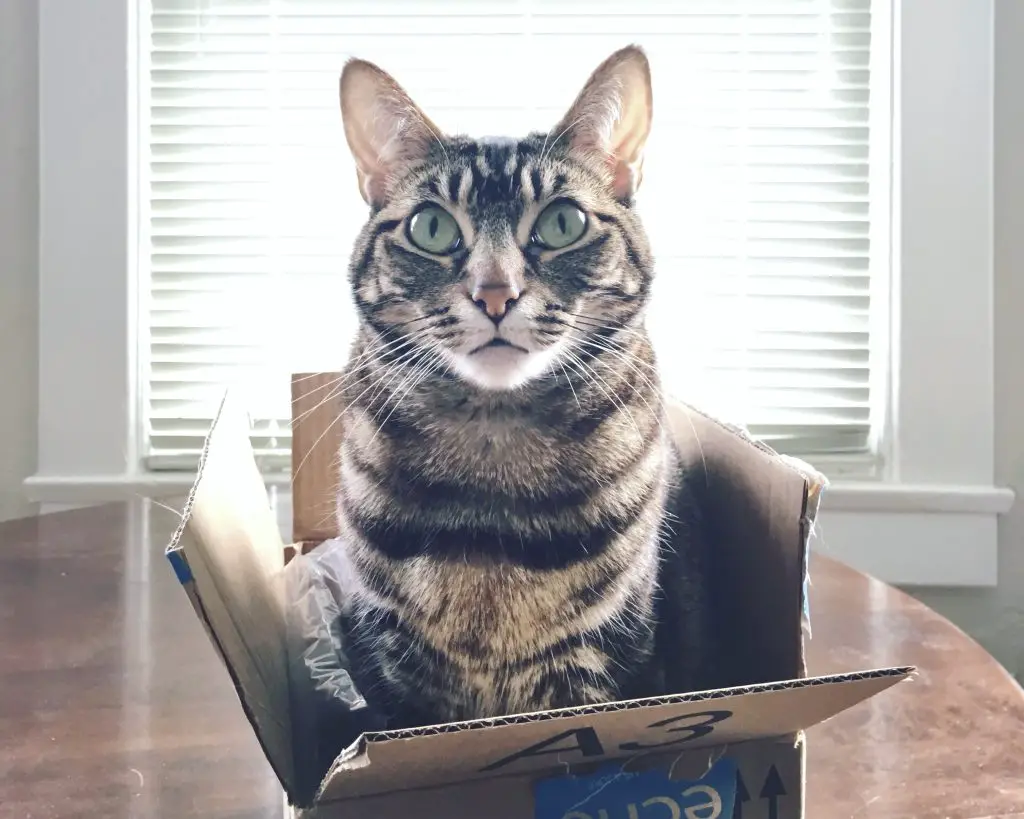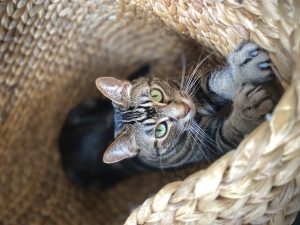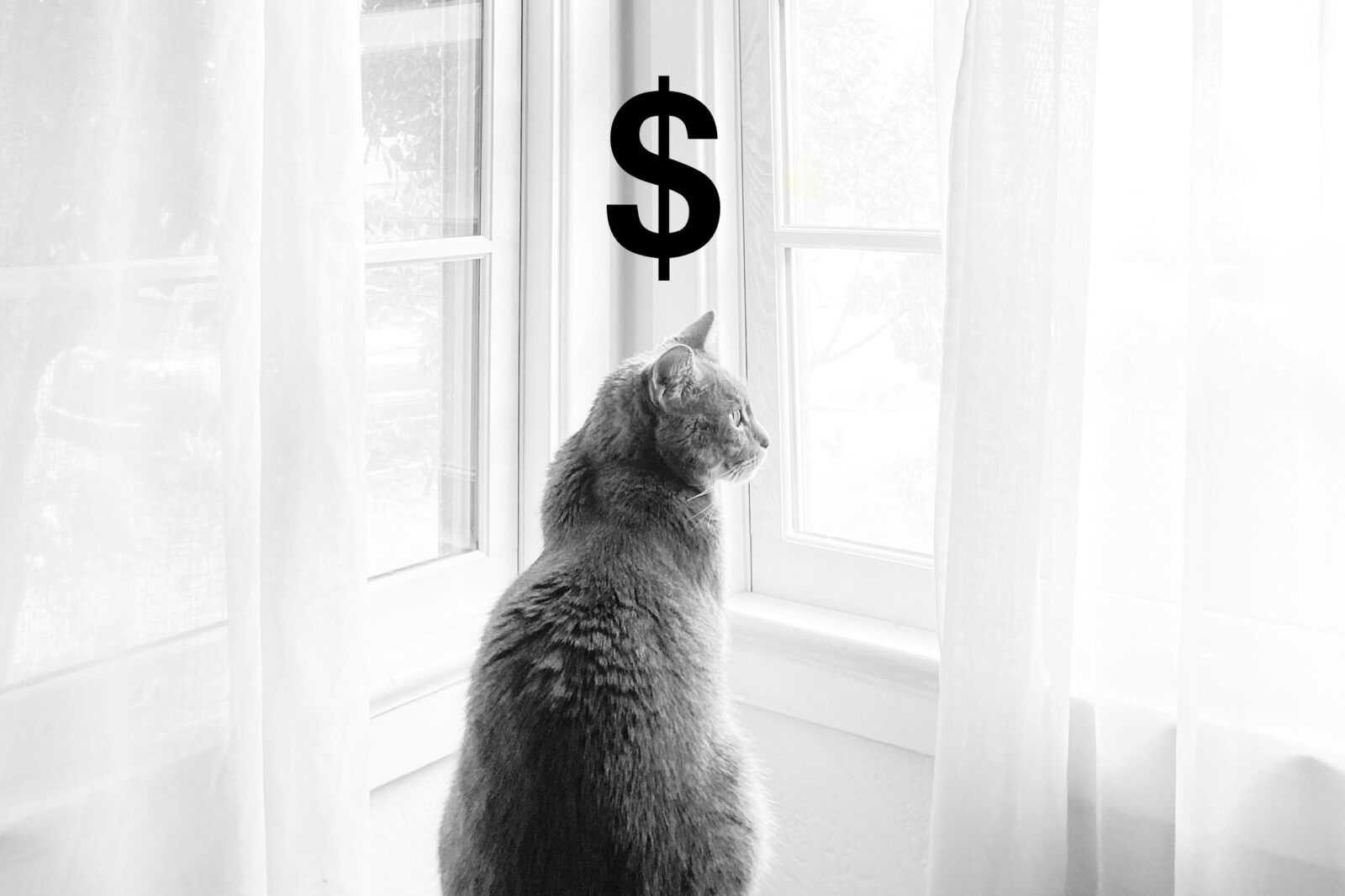Essential Supplies Checklist: Guide for New Cat Owners
Wondering what supplies you need to get started with your new kitten or cat?
In this article, you’ll find the essentials checklist along with typical price ranges for each item. Below that, details are provided for each item on the list.

Table of Contents
The table below contains an itemized list of the things you’ll need to get started, along with the price range for each. You can keep your cat budget down by selecting items on the cheaper end of the range.
Items with an *asterisk are must-haves to start.
Now that you know what’s on the list, let’s consider some important details about each item.
Affiliate Disclosure: VerveCat is supported by readers. As a member of Amazon Associates and other affiliate programs, we may earn a commission at no added cost to you when you follow a product link and make a purchase.
Pet Carrier ($30-$85)
When you first get your new kitten or cat, in some cases you might end up leaving the shelter or adoption event with a cat in a card-board box designed to be a make-shift pet carrier.
And you might be tempted to let that be your permanent cat carrier, rather than spending money on a formal version. I am not proud to admit that I fell into that trap myself at first. Luckily, nothing horrible ever happened, but I do regret it.
A quality pet carrier is worth the cost, for a few reasons.
Reason 1: Safety and Security
The first is that it’s just safer and more secure. A stressed out cat can bust out of a box pretty easily. And if that happens, it could be while you are driving or in a location far from home – like the vet’s office parking lot next to a busy road.
In contrast, a quality pet carrier is designed to ensure your cat cannot break free when closed properly.
Reason 2: Comfort and Reduced Stress
Another important reason is the comfort of your cat. Yes, you can put a towel or blanket in a box, but your cat is going to slip and get jostled around. That’s not only unsafe, but it also adds to the stress your cat will probably already be experiencing.
A quality carrier will have an interior that is sturdy, soft, and padded. This allows your cat to maintain his position and footing. And it will have good ventilation that doesn’t require a box cutter.
Reason 3: Ease of Entry
You also want a carrier that makes it as easy as possible to get your cat in and out of it.
If you take the time to train a cat for it, some will not resist being placed in a carrier container. But most cats quickly associate the carrier with a trip to the vet’s office, and will probably not voluntarily get in if they suspect that that is what’s afoot.
Carriers have openings that open and close safely and won’t require duct tape. Many also have the option of top-loading, which can make the endeavor of getting the cat in a whole lot easier. Easier = less stressful for you and your cat.
What to Look for in a Pet Carrier for Your Cat
- Both Top- and End-Loading
- A sturdy floor
- A padded bottom
- Good ventilation
- Easy to wash
- Quality zippers/latches that open and close securely and safely
- If it’s important to you, dimensions for air travel compliance
The cat carrier I use now:
Sherpa Original Deluxe Airline Approved Dog & Cat Carrier Bag (Amazon)
Litter Boxes ($15-$80)
There are a few factors to consider with litter boxes, and you may find out that you need a certain kind of box according to your cat’s unique preferences and, um – style, if you will.
A litter box must meet a few minimum requirements. It has to be sturdy, leak-proof, and washable.
It also needs to have walls that are high enough to contain most (ideally, all) of the mess. This is where it starts to depend on the cat. Some male cats are “high peers,” and I know from experience, because Gandalf is one of those male cats. Occasionally, he neglects to squat down very far, and ends up shooting a stream over the wall of the box.
If this also describes your male cat, you may find yourself needing to upgrade from a basic litter box pan to one with higher walls, or even one that has top-entry.
I have recently moved to a top-entry box and am pleased with the results. No more high-peeing incidents or litter flung onto the floor by mistake. And when the cats exit onto the roof of the box, some of the litter in their paws comes off right there in that spot, rather than being tracked into the kitchen like before.
I recommend starting with a cheap, basic tray with walls at least about 6 inches high. Then you can observe your cat’s habits and make adjustments as needed.
The litter boxes I use:
Iris Round Top Entry Litter box and Scoop (Amazon)
Cheaper version of the Iris Top Entry w/Scoop (Amazon)
I switched to these from the common front-entry covered box because Gandalf is a “high-pee-er” (some male cats will pee over the top edge of the box). Totally solved the issue and all three of my cats started using it without a hiccup.
Litter ($10-$30)
Cat litter can be a little daunting to figure out at first because there are many varieties and you may not know what your cat prefers or may reject. Some cats can be picky.
There’s clumping and non-clumping, flushable, scented and unscented. In table below, we have provided each type of cat litter along with some pros and cons for each.
Keep it Simple in the Beginning
In a lot of cases, you can find out ahead of time what litter your new cat is already using. Then you can just get the exact same kind of litter to start with in your own home. This will make litter box training easier.
You’ll be able to experiment with different litter types or brands later if you’re curious about switching. But don’t do this until your cat has been using the litter box reliably for a while in your home.
Of course, if your cat is not using the litter box reliably, then trying other kinds is something you may want to do sooner than later if the reason seems to be that your cat doesn’t like the litter itself. Be sure to our article on how to train a cat to use the litter box, so that you get off to a good start in that department.
Here are the 10 main types of litter on the market:
The 10 Main Types of Cat Litter on the Market
Corn-based
Clay-based clumping
Clay-based non-clumping
Wheat-based
Pine pellets
Walnut shells
Wood Pellets or recycled paper
Silica gel-based
Grass-based
Coconut husks
Keep in mind, it may take some trial and error to find the litter that works best for you and your cat.
The litter I use:
Dr. Elsey’s Premium Clumping Cat Litter – Ultra (Amazon)
Food and Water Bowls ($0-$30)
While these are essential items, this is probably the easiest area for improvisation with stuff you already have in your kitchen. You can use pretty much any containers in the short-term. I’ve used tupperware and even my own plates and cereal bowls in a pinch.
So you can take your time to find the perfect set. But you’re going to want to have designated bowls that are easily washable – all the better if you’ve got a dishwasher. Pet stores will have a variety of ceramic, aluminum, and stainless steel options.
Ceramic looks nicer in my opinion, but also runs the risk of breakage. I dropped one of my ceramic food bowls on the tile floor at feeding time and it shattered. Luckily, no cat injuries occurred. I decided to switch to aluminum after that.
I recommend having two or three sets of bowls per cat. This way, you can wash them every couple of days and always have a clean set to swap out for the set that needs to be cleaned. I have three sets and just wash them in the dishwasher.
Here’s what I use:
Van Ness Stainless Steel 16 OZ Food Dish (Amazon)
I like these food dishes because they’re indestructible and easy to throw in the dishwasher. And, they’re cheap so I can have several per cat – that way I always have clean bowls to use.
Food ($20-$30)
Just as with litter, hopefully you will adopt your cat with the knowledge of what they already like to eat. If that’s the case, then you should start with that exact same food. As long as it is high quality and meets the cat’s nutritional needs for its age and weight.
If you want to switch foods, phase the new food in over several days by slowly decreasing the amount of old food and increasing the amount of new food given at each meal.
I tend to get higher-end food for my kitties, but you can definitely get decent-quality food for cheaper than what I’m giving my cats if your budget is tight.
My favorite cat foods so far:
I’m in love with this family-run dog and cat food maker. Most importantly, the food is top notch quality and my cats love it. But on top of that, the variety is truly amazing (I find it a bit overwhelming, actually), and their sense of humor in naming each flavor is quite entertaining.
They also sell cans larger than 3oz size – they have 6oz and 10oz sizes, which are a must for people who have more than one cat. In my opinion, this is something that needs to change in the cat food industry – we need options in larger, more economical sizes!
My cats’ favorite at the moment is the Truluxe Mediterranean Feast.
Open Farm is awesome because the ingredients are high quality and ethically sourced. Worth it if you can afford it. I definitely can’t afford it as a full-time offering, but I do like to get a case of the wet food every once in a while.
I don’t give my cats much dry food, but when I do, I feed them Open Farm dry food because of the high quality.
Cat Beds ($10-$50)
Cat beds are, well, cat-sized beds made specifically for cats to sleep or curl up in. They are typically made of some kind of padding or cushion covered by a soft, synthetic material. Cat beds may be covered or hooded, or have low structured “walls” around the perimeter. Others are simply flat discs or rectangles.
Separate cat beds are nice to have for a few different reasons.
They can be moved around the house according to where your cat likes to hang out or sleep.
You can also place them strategically if you are trying to keep a surface free of cat hair. For example, your cat may love to sleep against your pillows on your bed, and you may not love the cat hair that ends up on your pillows. That’s a good spot to put a cat bed after you make your bed each day.
You can incorporate them into cat condos and sleeping nooks.
They’re a great way to customize spaces you want to design to be cat-friendly.
Look for beds that are easy to wash, such as those featuring removable and machine-washable covers. If you know the kind of texture or fabric your cat likes, you can probably find one to fit that preference. If you have two or more cats, get a bed big enough for more than one cat.
Cat beds can also be improvised with stuff you already have. For example, I have two cat beds that are simply baskets lined with PBG’s favorite fleece blankets.
Scratchers & Scratching Posts ($10-$50)
Scratchers usually come in the form of a board or post wrapped in sisal rope, or a block of dense, corrugated cardboard. These are a must-have for any cat home.
Cats have an innate need to scratch things in order to keep their claws and paws healthy. This behavior is natural and necessary, not something that is naughty or bad that should be punished. And of course, the practice of surgically removing claws from cats’ paws has been rightly seen for a long time now as cruel and wrong.
In order to avoid having your cat scratch your furniture, you should place scratchers and scratching posts strategically in your home. And you should have them in place before you bring your new cat home.
Here’s a rundown of my current fleet of scratchers:
There’s a sisal rope scratcher built into each of my two cat climbers, located in two different rooms.
I have a pyramid-shaped corrugated cardboard one that my cats love to perch on top of and then reach down toward the floor to scratch. That sits in the living room near the sofa.
And then I have a variety of rectangular cardboard blocks placed near most furniture, and those are just lying flat on the floor. My cats stand on top of it as they scratch it. Some cats, like my sister’s cat, Shadow, seem to prefer to sleep on one of these scratching blocks over much softer alternatives.
If you’re providing vertical scratching surfaces, just make sure they’re secure and stay put. The last thing you want is for your cat to be scared of scratching posts because they tip over onto them when they try to scratch. And if the scratcher wobbles around a lot, your cat will probably favor your sofa.
Cat Trees, Cat Condos, and Other Furniture ($25-$200+)
Cat trees, condos, and climbers come in many sizes and heights, and all sorts of designs and configurations. The typical one is covered in carpet, has multiple platforms, and perhaps an enclosed nook or two. Many also incorporate a toy or a scratching post.
This cat furniture serves a few important functions.
Cats love to climb and observe their surroundings from up high. If you don’t provide things for them to climb up on, they will probably try to climb whatever else happens to be in the room if they can.
Cats love cozy, secure nooks to sleep in. I think mine like doing this for the extra body heat that gets trapped in the enclosure as they snooze.
Cat trees also give cats appropriate activities and exercise, making it a valuable way of maintaining health.
Finally, a well placed cat tree can naturally channel your cat’s behavior into space that’s intended for your cat, and away from spaces that you want to keep clear of cat activity or cat hair.
I find many traditional cat trees (like the two I have) kinda ugly to be honest, but there are also some really creative and tasteful options out there to choose from. For example, there are end tables with beds inside, platforms that are installed in your wall like shelves, cat boxes that are designed to hang or attach on window sills, and so much more.
My favorite specialized cat spaces are window boxes and catios. Window boxes attach on the outside of your house over a window. Catios are like screened porches that are converted to a specialized room just for cats. Some day, I will have at least one of these for my cats. Some day!
Grooming Brush and Claw Trimmer ($5-$15 each)
All cats need to be brushed, some more than others. The frequency of brushing needed will also likely increase in warmer summer months when cats shed more. And long-haired cats need more frequent brushing than short-haired.
All cats also need to have their claws trimmed regularly. This helps your cat by maintaining paw health, and helps you because your cat’s claws won’t be razors that slice through your skin when you’re playing keep away or wrestling.
You want to have these things on hand before you get your cat so that you can expose them to brushing and trimming from the very beginning. That way, they will tolerate it or even enjoy it, rather than it being an unpleasant battle that your cat wants little part of.
Toys ($0-$30)
The world of cat toys is fun. There are so many things you can try with your cat to see which ones get them in play or hunt mode the best. Many toys mimic animals or insects that cats would normally hunt and catch. These include mice, birds, and insects.
My cats love the boingy springs, which come in packs of 10 or 12 for just a few dollars. They also love wadded up paper from packing materials.
Gandalf goes absolutely mental over the wand toy with feathers at the end of a string.
An important note: many toys require supervision of your cat’s use of them. You should evaluate each toy you buy for whether it is safe to just leave out for your cats at all times. For example, Gandalf loves the feather toy so much that he will actually eat all the feathers if I leave it laying around. So I have to hide it in a place he can’t get to it.
Don’t Forget: Adoption Fee and First Vet Visit ($100-$450)
This article covers the essential items and supplies you will need to purchase or acquire to be ready to bring a new cat home. There is one other significant source of up-front costs as you’re starting out: the adoption fee and initial vet visit, including spay/neuter, vaccinations, and microchip.
Sometimes these things will already be taken care of by the rescue agency or because you’re adopting an adult cat. In that case, the costs for those things will be part of the adoption fee.
Sometimes those things are not done yet, and the adoption agency will require you to cover the costs and arrange for the visit and procedures as part of the adoption agreement.
Depending on which things you need done, this will likely run you somewhere between $100 – $450.
Last Meows
The essential supplies along with adoption/vet fees will cost you at least around $500 to get started in the first month. Remember, you’ll need most of the things on this checklist before you bring your new cat home, so you can be prepared with a properly cat-proofed home.
And enjoy these special first days with your new kitty! Next, get to know the signs your new cat is adjusting well.


